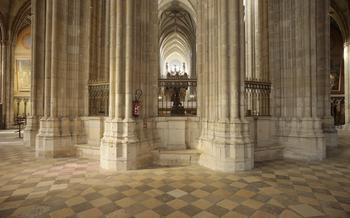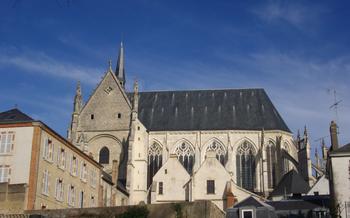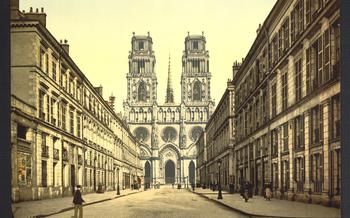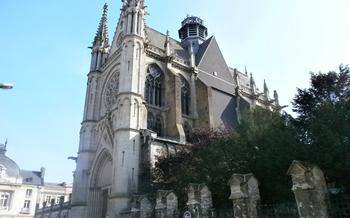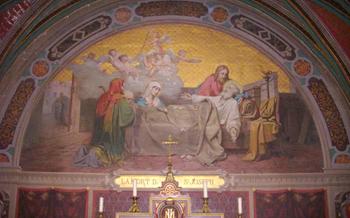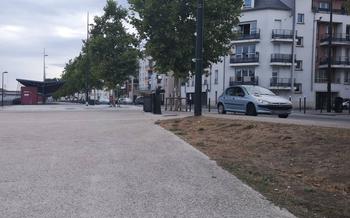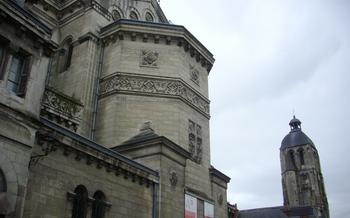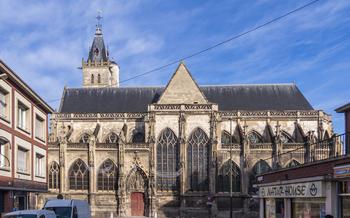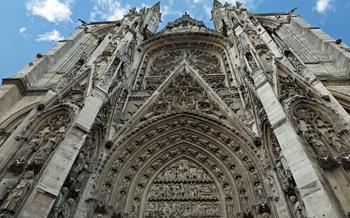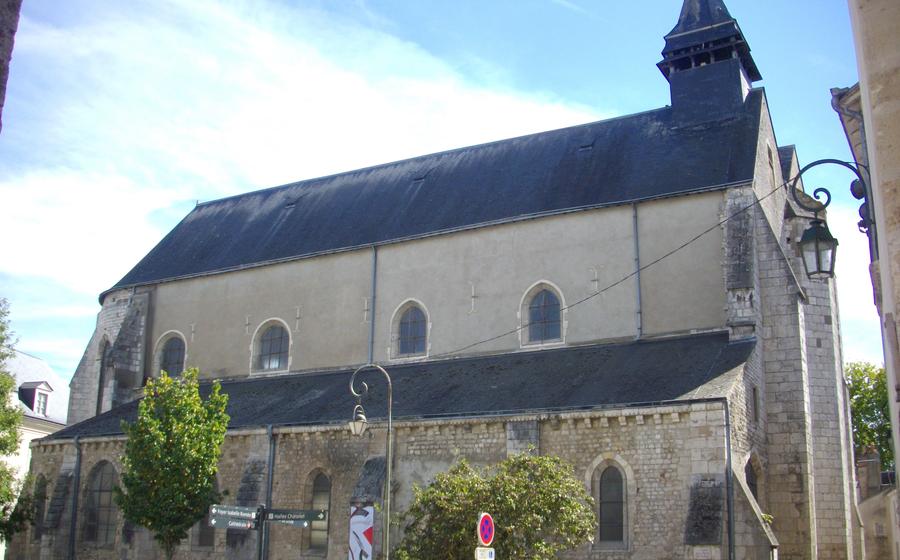
Église Saint Pierre le Puellier
- Église Saint Pierre le Puellier, a Hidden Gem in Orléans
- A Journey Through Time: Exploring the Église Saint Pierre le Puellier
- Unveiling the Architectural Masterpiece
- A Symphony of Light: The Stained Glass Windows
- A Place of Worship and Reflection
- Église Saint Pierre le Puellier in Art and Literature
- Practical Information for Visitors
- Capturing the Essence: Photography and Videography
- Exploring the Neighborhood: What to See and Do Nearby
- Events and Festivals at the Église Saint Pierre le Puellier
- Église Saint Pierre le Puellier in Literature and Film
- Insider Tip: Hidden Details to Look For
Église Saint Pierre le Puellier, a Hidden Gem in Orléans
Nestled amidst the vibrant city of Orléans, the Église Saint Pierre le Puellier stands as a testament to the city's rich history and architectural heritage. With its origins dating back to the 11th century, this ancient church has witnessed centuries of devotion, transformation, and cultural significance.
History
The story of the Église Saint Pierre le Puellier is intertwined with the development of Orléans itself. Founded in the 11th century as a Benedictine priory, the church underwent several expansions and modifications over the centuries, blending Romanesque and Gothic architectural styles. It served as a significant religious center, hosting prestigious ceremonies and attracting pilgrims from across the region.
Architecture
The Église Saint Pierre le Puellier is a captivating example of Romanesque-Gothic architecture. Its sturdy structure, characterized by thick walls and rounded arches, reflects the Romanesque style prevalent in the 11th century. The addition of pointed arches, ribbed vaults, and intricate carvings during the Gothic period transformed the church's appearance, creating a harmonious blend of architectural styles.
Stained Glass Windows
One of the church's most striking features is its collection of vibrant stained glass windows. These masterpieces of medieval craftsmanship depict biblical scenes and narratives, casting a kaleidoscope of colors onto the church's interior. The windows not only serve as decorative elements but also provide a glimpse into the religious and artistic traditions of the Middle Ages.
Statues and Sculptures
Throughout the church, visitors can discover an exquisite collection of statues and sculptures. These intricate works of art depict religious figures, saints, and biblical characters, adding a layer of spirituality and symbolism to the church's interior. The sculptures showcase the skill and artistry of medieval craftsmen, capturing the essence of religious devotion and storytelling.
A Journey Through Time: Exploring the Église Saint Pierre le Puellier
Embark on a journey through time as you explore the Église Saint Pierre le Puellier. Guided tours led by knowledgeable historians bring the church's rich history and symbolism to life. Listen to captivating tales of its construction, its role in significant historical events, and the stories behind its stunning artwork.
For a more intimate experience, opt for a self-guided tour. Wander through the church at your own pace, marveling at its intricate details and absorbing the serene atmosphere. Take advantage of the interactive displays that bring the church's history to life with multimedia presentations and touchscreens.
Participate in educational programs and workshops offered by the church to delve deeper into its significance. These programs provide a unique opportunity to learn about medieval architecture, religious art, and the church's role in the community.
Unveiling the Architectural Masterpiece
The Église Saint Pierre le Puellier stands as a testament to the architectural prowess of the medieval era. Its Romanesque foundation, dating back to the 11th century, is evident in its sturdy walls, rounded arches, and groin vaults. The church's subsequent Gothic additions, made in the 13th and 14th centuries, brought a sense of height and luminosity, characterized by pointed arches, ribbed vaults, and large stained glass windows.
The exterior of the church is adorned with intricate carvings and moldings that depict biblical scenes and figures. The main portal, with its three receding arches, is a masterpiece of Romanesque sculpture, featuring intricate carvings of saints, apostles, and mythical creatures. The tower, added in the 15th century, offers panoramic views of Orléans and the surrounding countryside.
Inside the church, the visitor is greeted by a harmonious blend of Romanesque and Gothic elements. The nave, with its massive pillars and rounded arches, creates a sense of strength and stability. The choir, with its intricate ribbed vaults and large stained glass windows, exudes an atmosphere of ethereal beauty. The capitals of the columns are adorned with a variety of sculptures, including human heads, animals, and plant motifs, each telling a unique story.
The Église Saint Pierre le Puellier is not just an architectural marvel but also a repository of symbolic meanings. The number three, representing the Holy Trinity, is recurrent throughout the church. The three portals, the three windows in the apse, and the three levels of the tower all allude to this sacred number. The church's orientation, with the apse facing east, symbolizes the rising of Christ and the hope of eternal life.
Exploring the Église Saint Pierre le Puellier is a journey through time, a journey that unveils the architectural genius and spiritual significance of this ancient place of worship.
A Symphony of Light: The Stained Glass Windows
The Église Saint Pierre le Puellier is renowned for its exquisite stained glass windows, which illuminate the interior with a kaleidoscope of colors. These magnificent windows, meticulously crafted by skilled artisans, depict captivating biblical narratives and serve as a testament to the power of storytelling through glass.
As you step inside the church, the vibrant hues of the stained glass immediately catch your eye. The windows, arranged in rows, form a symphony of light that dances across the stone walls, creating an ethereal atmosphere. Each window tells a different story, drawn from the Bible and the lives of saints.
One of the most striking windows depicts the creation of the world, with God separating light from darkness and bringing forth the heavens and the earth. Another window portrays the Annunciation, where the angel Gabriel visits Mary to announce the birth of Jesus. The Crucifixion, the Resurrection, and the Ascension are also depicted in stunning detail, inviting visitors to contemplate the life and sacrifice of Christ.
In addition to their religious significance, the stained glass windows also offer a glimpse into the artistic and cultural context of the Middle Ages. The intricate designs, vibrant colors, and expressive figures reflect the Gothic style that was prevalent at the time. The windows served as a form of visual storytelling, educating the illiterate population about biblical stories and conveying moral lessons.
Today, the stained glass windows of the Église Saint Pierre le Puellier continue to captivate visitors with their beauty and symbolism. They stand as a testament to the artistry and devotion of the medieval craftsmen who created them, and serve as a reminder of the enduring power of stained glass as a medium for storytelling.
A Place of Worship and Reflection
The Église Saint Pierre le Puellier holds immense religious significance and has served as a center of worship for centuries. It is a place where the local community gathers for masses, prayers, and other religious ceremonies. The church's sacred space exudes an atmosphere of tranquility and serenity, inviting visitors to find solace and spiritual connection. Throughout history, the church has also been a popular pilgrimage destination for those seeking spiritual guidance and blessings.
Église Saint Pierre le Puellier in Art and Literature
The Église Saint Pierre le Puellier has been immortalized in various artistic mediums, weaving its way into the cultural fabric of Orléans. Artists, writers, and historians have found inspiration within its sacred walls.
Artistic Depictions: Throughout history, the church has served as a muse for artists who have captured its beauty and grandeur in paintings, drawings, and engravings. These works of art offer a unique perspective on the church, allowing viewers to appreciate its architectural details and the emotions it evokes.
Literary Allusions: The church's rich history and captivating atmosphere have found their way into the realm of literature. In novels, poems, and short stories, authors have woven the church into their narratives, using it as a setting for dramatic events or as a symbol of faith and resilience.
Historical Accounts: Historians and chroniclers have documented the church's significance in historical texts, providing valuable insights into its role in the religious, social, and cultural life of Orléans. These accounts offer a glimpse into the church's past, shedding light on its construction, modifications, and the events that have shaped its history.
Cultural Symbol: The Église Saint Pierre le Puellier has become a cultural symbol, representing the city's rich heritage and enduring spirit. Its distinctive silhouette and intricate details have made it a recognizable landmark, deeply embedded in the collective memory of Orléans and its inhabitants.
Practical Information for Visitors
To fully immerse yourself in the history and beauty of the Église Saint Pierre le Puellier, it's important to plan your visit effectively. The church is conveniently located in the heart of Orléans, making it easily accessible on foot or by public transportation. Detailed information about the church's address and transportation options is readily available online or at the Orléans tourist information center.
Visiting hours vary depending on the season and day of the week, so it's advisable to check the church's official website or call ahead to confirm the exact timings. Admission to the church is generally free, allowing you to explore its wonders without any financial constraints.
For those seeking a deeper understanding of the church's significance and symbolism, guided tours are offered in various languages throughout the week. These tours provide valuable insights into the church's history, architectural features, and religious significance.
Accessibility is a priority at the Église Saint Pierre le Puellier. The church is equipped with ramps and elevators, ensuring that visitors with disabilities can comfortably access all areas of the building. Additionally, there are designated seating areas for wheelchair users, allowing them to fully participate in services and events.
Capturing the Essence: Photography and Videography
The Église Saint Pierre le Puellier welcomes visitors to capture the beauty of its sacred space through photography and videography. However, certain guidelines must be followed to ensure respect for the church's sanctity and preserve its artistic integrity.
Photography is permitted for personal, non-commercial use only. Tripods, flash photography, and the use of artificial lighting are generally not allowed, as they may disrupt the ambiance of the church and damage sensitive artifacts.
To capture stunning photographs, it's essential to consider the lighting conditions and angles. The church's stained glass windows are particularly mesmerizing when photographed at specific times of the day, such as early morning or late afternoon, when the sunlight casts vibrant hues and shadows throughout the interior.
Videography is also permitted, but prior authorization from the church authorities is required. Videographers are expected to respect the church's sacred nature and avoid any activities that may disturb ongoing religious services or ceremonies.
By following these guidelines and capturing the essence of the Église Saint Pierre le Puellier through your lens, you can share its beauty and history with others while preserving its sanctity for generations to come.
Exploring the Neighborhood: What to See and Do Nearby
Located in the heart of Orléans' historic center, the Église Saint Pierre le Puellier is surrounded by a vibrant neighborhood teeming with attractions, shops, and dining options. A short walk from the church, you can discover the following hidden gems:
-
Hôtel Groslot: This Renaissance-style mansion houses the Musée Historique et Archéologique de l'Orléanais, showcasing artifacts from the city's rich past.
-
Maison de Jeanne d'Arc: Immerse yourself in the life of Joan of Arc at this museum dedicated to the iconic French heroine.
-
Place du Martroi: Wander through this lively square adorned with a magnificent fountain and surrounded by charming cafes and boutiques.
-
Rue de Bourgogne: Explore this picturesque street lined with colorful half-timbered houses and independent shops.
-
Marché de l'Étape: Experience the sights, sounds, and flavors of this vibrant local market, offering fresh produce, artisanal products, and regional specialties.
-
Cathédrale Sainte-Croix d'Orléans: Admire the stunning stained glass windows and Gothic architecture of this magnificent cathedral.
-
Parc Pasteur: Take a leisurely stroll through this tranquil park, enjoying its lush gardens, playgrounds, and serene atmosphere.
-
Musée des Beaux-Arts d'Orléans: Discover a collection of fine art spanning from the Middle Ages to the 20th century at this renowned museum.
Events and Festivals at the Église Saint Pierre le Puellier
The Église Saint Pierre le Puellier is not just a place of worship but also a venue for various events and festivals throughout the year. These events celebrate the church's rich history, showcase its architectural beauty, and foster a sense of community among visitors and locals alike.
One of the most significant annual celebrations is the Feast of Saint Peter the Apostle, the church's patron saint. Held on June 29th, this festival features a special mass, processions, and musical performances. The church is adorned with flowers and decorations, creating a festive atmosphere that attracts visitors from near and far.
Music lovers can delight in the church's organ recitals, which take place regularly and showcase the talents of renowned organists. The church's acoustics provide an exceptional backdrop for these concerts, allowing the music to reverberate throughout the sacred space.
In addition to religious celebrations, the Église Saint Pierre le Puellier also hosts art exhibitions and displays. These exhibitions showcase religious art, artifacts, and historical documents related to the church and its history. Visitors can explore these displays to gain a deeper understanding of the church's significance and its role in the community.
The church also organizes community events and workshops that bring people together and foster a sense of belonging. These events may include lectures, workshops on religious topics, and social gatherings. Participating in these events offers visitors a chance to connect with the local community and learn more about the church's ongoing initiatives.
Église Saint Pierre le Puellier in Literature and Film
The Église Saint Pierre le Puellier has captured the imagination of writers and filmmakers, inspiring works of fiction and non-fiction that bring the church and its history to life. Several historical novels set in Orléans feature the church as a backdrop, weaving its architectural beauty and spiritual significance into their narratives. Book clubs and discussions centered around these novels offer readers an opportunity to explore the church's literary connections and delve deeper into its historical context.
In the world of cinema, documentaries and feature films have showcased the church's architectural splendor and its role in Orléans' history. These audiovisual productions provide a visual journey through the church's sacred spaces, allowing audiences to appreciate its intricate details, stained glass windows, and sculptures. Literary tours that incorporate the church invite visitors to follow in the footsteps of fictional characters and explore the real-life settings that inspired their stories.
Through these literary and cinematic representations, the Église Saint Pierre le Puellier transcends its physical form and becomes a symbol of Orléans' rich history and cultural heritage. It invites visitors to engage with the church not only as a religious monument but also as a source of inspiration and artistic expression.
Insider Tip: Hidden Details to Look For
As you explore the Église Saint Pierre le Puellier, keep an eye out for the hidden details that add depth and intrigue to this ancient church. Look for cryptic symbols and carvings adorning the walls and pillars, each holding a unique symbolic meaning. Discover unusual architectural curiosities, such as a hidden staircase or a secret chamber, that may go unnoticed at first glance.
Don't forget to admire the stained glass windows, and take the time to read the stories they depict from left to right. Each window tells a captivating biblical narrative, and the vibrant colors and intricate designs will leave you in awe.
Finally, listen closely for the faint whispers of angels in the church's acoustics. It is said that the whispers are the voices of the saints and martyrs who once worshipped within these walls. Close your eyes and let the whispers transport you back in time, immersing you in the rich history and spiritual essence of this sacred space.
